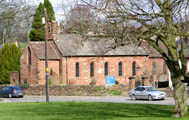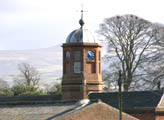|
|
THE NIGHT LANGWATHBY BRIDGE WAS SWEPT AWAY
(Based on an article in The Cumberland Herald by courtesy of the C&W Herald)
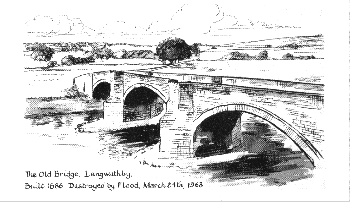 In the darkness of an early March morning in 1968, with a gale howling out of the West and flood waters thundering down the Eden, the 300-year-old bridge which carried the Penrith to Alston road over the river at Langwathby, collapsed without warning In the darkness of an early March morning in 1968, with a gale howling out of the West and flood waters thundering down the Eden, the 300-year-old bridge which carried the Penrith to Alston road over the river at Langwathby, collapsed without warning
An eighty-yard gap opened up in the road and the remains of the bridge settled in a pile of rubble among the fury of the swollen river.
Ten minutes earlier a Melmerby man had driven over the bridge towards Penrith, found the road beyond flooded and reversed to the Langwathby side. The driver, Mr. Peter Smith, Milestone House, went to a telephone and was calling Penrith when the line went dead as the bridge collapsed, cutting all the cables buried in the roadway. It was then 5-20 am.
As they use the temporary girder bridge over the Eden, which was intended to last no more than ten years, the people of the area still talk about the storm, which hit the district on the night of Saturday 23rd March, 1968.
It caused flooding and very extensive damage along the length of the Eden, with Appleby especially hard hit, but the greatest drama was the collapse of Langwathby bridge early the next morning.
Mr. Jim Monkhouse, Langwathby, had stood on the bridge at midnight and felt it trembling under the weight of water. He believed that a large tree, swept down by the flood, must have struck the keystone of the pier on the Langwathby side, demolishing the support and bring down the roadway.
Some time earlier the roadway on the Penrith side of the bridge had been raised several feet on an embankment and Mr. Monkhouse believed that this could have contributed to the disaster by forcing the flood water back into the channel under the bridge.
The raising of the road did not prevent it being flooded as far back as the. Edenhall-Great Salkeld crossroads and the occupants of the Toll Bar Cottage, at the crossroads, had to be evacuated by Penrith firemen in the early hours of the Sunday.
The news of the collapse of the bridge was given on radio and this brought hundreds of sightseers to both sides of the bridge on the Sunday.
Among them was Mr. Edward Short, then Postmaster General in the Labour Government, who watched an enterprising effort by Post Office engineers to restore communications to the Langwathby area.
ARCHER CALLED IN
The engineer-in-charge, Mr. Herbert Haythornthwaite, tried throwing lines across the river without success and then recruited champion archer Mr. David Farrer, Carleton, Penrith, to try firing an arrow across.
Using a bow belonging to the son of Mr. Norman Little, Langwathby, Mr. Farrer shot several across the river but the lines proved too heavy. Then an angler offered him a length of fishing line and the arrow carried this light nylon line over the eighty-yard gap.
Heavier lines were pulled over and then a cable and within a short time Mr. Short was able to use the telephone to congratulate Mr. Haythornthwaite, on the far side of the river.
The old bridge had stood from at least 1686, the date cut on one of the facing stones. Early bridges across the Eden were stock-bridges, with planks on bearers resting on logs or stocks. These stocks were later replaced by "jewels" or stone pillars, but stone arches did not appear in this part of the country until after the Restoration in 1660.
In neighbouring Westmoreland, the Quarter Sessions carried out an investigation into the condition of bridges after the disastrous Civil War and in 1679 ordered that 5d in the £ be levied upon the Barony of Appleby for the next seven years for the reparation of bridges. At the end of the seven years, in 1686, they ordered an inspection of the repaired bridges.
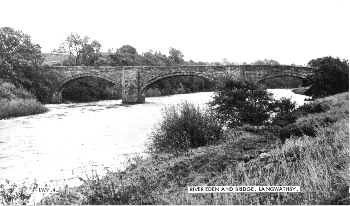 SWEPT AWAY
The date of the Langwathby bridge suggests that Cumberland might have carried out a similar exercise and that a new bridge might have been built at Langwathby or, at least, extensive repairs done. Two earlier bridges near the village had been swept away by floods. SWEPT AWAY
The date of the Langwathby bridge suggests that Cumberland might have carried out a similar exercise and that a new bridge might have been built at Langwathby or, at least, extensive repairs done. Two earlier bridges near the village had been swept away by floods.
The first arched stone bridges were narrow pack-horse bridges which served for centuries. Then, with more vehicular traffic and the coming of the turnpike roads, new arches were often built on the upstream side of the earlier bridges to strengthen them and widen the roadway.
This probably happened at Langwathby but there is no record of bridge improvements until 1932, when the roadway of the bridge was strengthened with concrete and steel piles were driven into the river bed upstream of the pillars.
From March 1968 until the end of May traffic was diverted by way of Culgaith but some Langwathby people left vehicles on the Penrith side of the bridge and crossed daily by boat.
The County Council had estimates for new bridges at two points, one 50 yards downstream, which would cost £370,000, and another 500 yards upstream, which would divert the road outside the village and which was estimated to cost £309,000.
REPLACEMENT
Meanwhile work began on erecting a temporary bridge. A metal girder bridge which had been placed over the damaged Portinscale Bridge, near Keswick, and which was not needed following the opening of a by-pass road into the village, was dismantled and brought to Langwathby.
It was said at the time that this would form part of the temporary Langwathby bridge but, in fact, it was used only during the construction of the existing girder bridge.
The Portinscale bridge was assembled at one side of the old bridge and pushed out on rollers over the gap. It was balanced on a pivot point and as it was advanced, sections of the present bridge were bolted to the end of it. More sections were added to balance the weight as the bridge was advanced towards the far side.
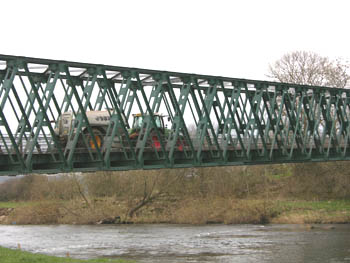 Finally the Portinscale bridge section reached the far side and was used to draw the larger sections across. As the process advanced, the Portinscale bridge was dismantled and removed. Finally the Portinscale bridge section reached the far side and was used to draw the larger sections across. As the process advanced, the Portinscale bridge was dismantled and removed.
The temporary bridge, with a one-way stream controlled by traffic lights was opened on 31st May 1968, and has been in use since.
THE MILLENNIUM SCHEME
In March 1995 the Parish Council decided to explore the possibility of a bid to the Millennium Fund to rebuild the bridge. By November the campaign had gathered momentum and support was reported from Cumbria County Council, Eden District Council, the Member of Parliament, Eden Arts, Voluntary Action Cumbria and local businesses.
The Millennium Commission accepted the proposal in outline and a steering group was set up to take the plans forward.
The detailed application with plans and architect's drawings was submitted in February 1996 and, later that year, a meeting was held with the Millennium Commission and the Royal Fine Arts Commission, who advised on the design.
The Millennium Commission agreed 50% funding of £1.9million but the whole scheme came crashing down when the Department of Transport declined to increase its grant to the County Council. This made it impossible for the County Council to contribute their share (£1.4million over 3 years) and thus to raise the match-funding required.
FLOODS THREATEN THE BRIDGE AGAIN
A severe storm led to extensive flooding of the River Eden on Saturday, 8th January, 2005. A month's rainfall is said to have fallen in 48 hours and was accompanied by very high winds.
Considerable damage was caused in the villages and alongside the River Eden. Toll Bar Cottage, New Mill and the Edenhall cricket pavilion were badly affected by flood waters and many homes and businesses were without electricity for up to five days.
Large craters were gouged out of the river banks and adjoining fields. The flood waters undermined the road leading to Langwathby Bridge and half the width of the carriageway had to be renewed. One of the large trees on Langwathby green threatened to fall and had to be cut down.
Langwathby Bridge became a visitor attraction as spectators from villages all around came to watch the flood waters racing through and around the abutments. There were fears that the bridge was being undermined but it survived the onslaught and there are no current plans for it to be replaced.
|
